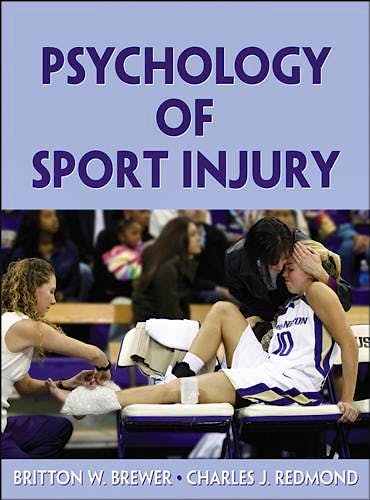

No hay productos en el carrito



Psychology of Sport Injury
Brewer, B. — Redmond, C.
1ª Edición Enero 2017
Inglés
Tapa blanda
300 pags
1000 gr
17 x 24 x 2 cm
ISBN 9781450424462
Editorial HUMAN KINETICS BOOKS
LIBRO IMPRESO
-5%
88,14 €83,73 €IVA incluido
84,75 €80,51 €IVA no incluido
Recíbelo en un plazo de
2 - 3 semanas
Description
From a gymnast hiding ankle pain so she can compete to a basketball player who withdraws from friends after a season-ending injury, it can be argued that every sport injuryaffects or is affected in some way by psychological factors. Given the widespread importance of psychological issues in sport injury, it is important for those working with athletes—injured or not—to be aware of the latest developments on the subject.
Written by a sport psychology consultant and an athletic trainer, Psychology of Sport Injuryprovides a thorough explanation of the elements and effects of sport injuries alongwith up-to-date research and insights for practical application. The authors offer a contemporary approach to preventing, treating, rehabilitating, and communicating professionallyabout sport injuries that takes into account physical, psychological, and social factors.
Psychology of Sport Injury presents sport injury within a broader context of public health and offers insights into the many areas in which psychology may affect athletes, such asrisk culture, the many facets of pain, athlete adherence to rehab regimens, the relationship between psychological factors and clinical outcomes, collaboration, and referrals foradditional support. The book explores the relevant biological, psychological, and social factors that affect given circumstances. The text consists of four parts: Understanding andPreventing Sport Injuries, Consequences of Sport Injury, Rehabilitation of Sport Injury, and Communication in Sport Injury Management.
Psychology of Sport Injury includes evidence-based examples and demonstrates real-world applications that sport health care professionals often face with athletes. Additionalpedagogical features include the following:
- Focus on Research boxes provide the what and why of the latest research to complement the applied approach of the text.
- Focus on Application boxes highlight practical examples to illustrate the material and maintain student engagement.
- Psychosocial content aligned with the latest educational competencies of the National Athletic Trainers’ Association (NATA) helps students prepare for athletic trainingexaminations and supports professional development for practitioners.
- A prevention-to-rehabilitation approach gives a framework for understanding sport injury, including precursors to injury, pain as a complex phenomenon, adherence torehabilitation, and communication and management of injuries with other health care professionals as well as the athlete.
- A presentation package aids instructors in lecture preparations.
Psychology of Sport Injury is an educational tool, reference text, and springboard to new ideas for research and practice in any line of work exposed to sport injury. Observingand committing to athletes, especially during times of physical trauma and emotional distress (which are often not separate times), are critical skills for athletic trainers, physicaltherapists, sport psychologists, coaches, and others who work with athletes on a regular basis.
Contents
Preface
Acknowledgments
Introduction: A Contemporary Approach to the Challenges of Sport Injury
Part I. Understanding and Preventing Sport Injuries
Chapter 1. Biopsychosocial Foundations of Sport Injury
- A Biopsychosocial Perspective on Sport Injury
- Biological Foundations of Sport Injury
- Psychological Foundations of Sport Injury
- Social Foundations of Sport Injury
- Biopsychosocial Analysis
- Summary
Chapter 2. Antecedents of Sport Injury
- Models of Sport Injury Occurrence
- Psychosocial Predictors of Sport Injury
- Mechanisms of Psychosocial Influence on Sport Injury Occurrence
- Biopsychosocial Analysis
- Summary
Chapter 3. Sport Injury Prevention
- Types of Prevention
- Models of Sport Injury Prevention
- Sport Injury Prevention Content Categories
- Biopsychosocial Analysis
- Summary
Part II. Consequences of Sport Injury
Chapter 4. Psychological Responses to Sport Injury
- Models of Psychological Response to Sport Injury
- Psychological Consequences of Sport Injury
- Biopsychosocial Analysis
- Summary
Chapter 5. Pain, Sport, and Injury
- Definitions of Pain
- Types of Pain
- Dimensions of Pain
- Measurement of Pain
- Models and Theories of Pain
- Factors Associated with Pain in Sport
- Interpreting and Acting on Sport-Related Pain
- Biopsychosocial Analysis
- Summary
Part III. Rehabilitation of Sport Injury
Chapter 6. Adherence to Sport Injury Prevention and Rehabilitation Programs
- Adherence to Sport Injury Prevention Programs
- Adherence to Sport Injury Prevention Programs
- Consequences of Adherence to Sport Injury Prevention and Rehabilitation Programs
- Biopsychosocial Analysis
- Summary
Chapter 7. Psychological Factors in Sport Injury Rehabilitation
- Sport Injury Rehabilitation Outcomes
- Charting a Course from Psychological Factors to Sport Injury Rehabilitation Outcomes
- Psychological Readiness to Return to Sport
- Biopsychosocial Analysis
- Summary
Chapter 8. Psychological Interventions in Sports Health Care
- Psychological Interventions in Sports Health Care
- Biopsychosocial Analysis
- Summary
Part IV. Communication in Sport Injury Management
Chapter 9. Communicating with Patients
- Context of Patient-Practitioner Communication in Sports Health Care
- Models of the Patient-Practitioner Relationship in Sports Health Care
- Congruence of Patient-Practitioner Perceptions in Sports Health Care
- Factors Affecting Patient-Practitioner Communication in Sports Health Care
- Biopsychosocial Analysis
- Summary
Chapter 10. Referring Athletes for Psychological Services
- Definition of and Rationale for Referral of Athletes for Psychological Services
- Socioclinical Context of Referral of Athletes for Psychological Services
- Reasons for Referral
- Referral Process
- Biopsychosocial Analysis
- Summary
References
Index
About the Author
© 2026 Axón Librería S.L.
2.149.0